Multi-Signal Induction Motor Broken Rotor Bar Detection Based on Merged Convolutional Neural Network
Abstract
1. Introduction
- A non-invasive, data-driven method for broken rotor bar detection is investigated. The method is based on motor currents, does not require invasive sensors, and has a straightforward, practical architecture.
- The adaptive demodulation transformation method is used for data preprocessing, without complex parameter adjustment. A deep neural network is used as a classifier for fault classification, without manual feature engineering.
- We demonstrated the robustness of the methodology through comprehensive experimental validation at multiple load levels (25%, 50%, 75%, and 100%) and fault levels (normal and 1-4 broken rotor bars).
- The metrics to evaluate the computational efficiency of the model training and testing procedures are calculated to demonstrate its real-time performance.
2. Theoretical Foundation
2.1. Principles of BRB and MCSA
2.1.1. Physical Structure and Fault Mechanism
2.1.2. Electromagnetic Field Effects
2.1.3. Motor Current Signature
- 1.
- Primary Sidebands:
- 2.
- Higher Order Sidebands:
2.2. Hilbert-Huang Transform
2.2.1. Empirical Mode Decomposition
- Initialization:
- 2.
- Extrema Identification:
- 3.
- Envelope Generation:
- 4.
- Mean Envelope Calculation:
- 5.
- Detail Extraction:
- 6.
- IMF Check (Inner Loop):
- 7.
- IMF Extraction and Residual Update:
- 8.
- Outer Loop Iteration:
- 9.
- Stopping Criterion (Outer Loop):
2.2.2. Hilbert Transform and Instantaneous Frequency
2.2.3. Computer Algorithm for Calculating the Analytic Signal
- x ← array(x)
- Xf ← fft(x)
- h ← zeros
- if N%2 = 0 then:h[0], h[N/2] ← 1, 1h[1:N/2] ← 2
- else: h[0]←1; h[1:(N + 1)/2] ← 2
- z ← ifft(Xf⋅h, axis)
- return z
2.3. Park’s Vector Analysis
2.4. Convolutional Neural Network Architecture
2.4.1. Convolutional Layer
2.4.2. Pooling Layer
2.4.3. Fully Connected Layer
2.4.4. Mish Activation Function
2.4.5. Model Training Process
2.4.6. Merged Model Architecture
3. Proposed Methodology
3.1. Data Collection and Segmentation
3.2. Data Preprocessing
3.3. Deep Learning Architecture
4. Experimental Validation
4.1. Experimental Test Results
4.2. Comparative Analysis
- Single-signal approaches using HHT or PVM with CNN classifiers.
- Wavelet transform-based time–frequency distribution (TFD) images with CNN classifiers.
- Various signal combination strategies in the merged CNN architecture.
4.3. Real-Time Performance Analysis
5. Conclusions and Future Work
Author Contributions
Funding
Data Availability Statement
Conflicts of Interest
References
- De Souza, D.F.; Salotti, F.A.M.; Sauer, I.L.; Tatizawa, H.; De Almeida, A.T.; Kanashiro, A.G. A Performance Evaluation of Three-Phase Induction Electric Motors between 1945 and 2020. Energies 2022, 15, 2002. [Google Scholar] [CrossRef]
- Bazzi, A.M.; Krein, P.T. Review of Methods for Real-Time Loss Minimization in Induction Machines. IEEE Trans. Ind. Appl. 2010, 46, 2319–2328. [Google Scholar] [CrossRef]
- Bonnett, A.H.; Soukup, G.C. Cause and Analysis of Stator and Rotor Failures in Three-Phase Squirrel-Cage Induction Motors. IEEE Trans. Ind. Appl. 1992, 28, 921–937. [Google Scholar] [CrossRef]
- Drif, M.; Cardoso, A.J.M. The Use of the Instantaneous-Reactive-Power Signature Analysis for Rotor-Cage-Fault Diagnostics in Three-Phase Induction Motors. IEEE Trans. Ind. Electron. 2009, 56, 4606–4614. [Google Scholar] [CrossRef]
- Corne, B.; Debruyne, C.; De Baets, P.; Desmet, J. Stator Current Measurements as a Condition Monitoring Technology—The-State-of-the-Art. In Proceedings of the 2014 International Conference on Electrical Machines (ICEM), Berlin, Germany, 2–5 September 2014; pp. 1659–1665. [Google Scholar]
- Faiz, J.; Ojaghi, M. Different Indexes for Eccentricity Faults Diagnosis in Three-Phase Squirrel-Cage Induction Motors: A Review. Mechatronics 2009, 19, 2–13. [Google Scholar] [CrossRef]
- Albrecht, P.F.; Appiarius, J.C.; McCoy, R.M.; Owen, E.L.; Sharma, D.K. Assessment of the Reliability of Motors in Utility Applications—Updated. IEEE Trans. Energy Convers. 1986, EC-1, 39–46. [Google Scholar] [CrossRef]
- Stone, G.C.; Sasic, M.; Dunn, D.; Culbert, I. Recent Problems Experienced with Motor and Generator Windings. In Proceedings of the 2009 Record of Conference Papers—Industry Applications Society 56th Annual Petroleum and Chemical Industry Conference, Anaheim, CA, USA, 14–16 September 2009; pp. 1–9. [Google Scholar]
- Hassan, O.E.; Amer, M.; Abdelsalam, A.K.; Williams, B.W. Induction Motor Broken Rotor Bar Fault Detection Techniques Based on Fault Signature Analysis—A Review. IET Electr. Power Appl. 2018, 12, 895–907. [Google Scholar] [CrossRef]
- Nandi, S.; Bharadwaj, R.; Toliyat, H.A.; Parlos, A.G. Study of Three Phase Induction Motors with Incipient Rotor Cage Faults under Different Supply Conditions. In Proceedings of the Conference Record of the 1999 IEEE Industry Applications Conference. Thirty-Forth IAS Annual Meeting (Cat. No.99CH36370), Phoenix, AZ, USA, 3–7 October 1999; Volume 3, pp. 1922–1928. [Google Scholar]
- Nandi, S.; Toliyat, H.A.; Li, X. Condition Monitoring and Fault Diagnosis of Electrical Motors—A Review. IEEE Trans. Energy Convers. 2005, 20, 719–729. [Google Scholar] [CrossRef]
- Gonzalez-Jimenez, D.; del-Olmo, J.; Poza, J.; Garramiola, F.; Madina, P. Data-Driven Fault Diagnosis for Electric Drives: A Review. Sensors 2021, 21, 4024. [Google Scholar] [CrossRef]
- Artesis Model Based Fault Detection Systems—Artesis. Available online: https://artesis.com/blog/ (accessed on 12 January 2025).
- Gawde, S.; Patil, S.; Kumar, S.; Kamat, P.; Kotecha, K.; Abraham, A. Multi-Fault Diagnosis of Industrial Rotating Machines Using Data-Driven Approach: A Review of Two Decades of Research. Eng. Appl. Artif. Intell. 2023, 123, 106139. [Google Scholar] [CrossRef]
- Niu, G.; Dong, X.; Chen, Y. Motor Fault Diagnostics Based on Current Signatures: A Review. IEEE Trans. Instrum. Meas. 2023, 72, 1–19. [Google Scholar] [CrossRef]
- Obaid, R.R.; Habetler, T.G. Effect of Load on Detecting Mechanical Faults in Small Induction Motors. In Proceedings of the 4th IEEE International Symposium on Diagnostics for Electric Machines, Power Electronics and Drives, SDEMPED 2003, Stone Mountain, GA, USA, 24–26 August 2003; pp. 307–311. [Google Scholar]
- Gyftakis, K.N.; Marques Cardoso, A.J.; Antonino-Daviu, J.A. Introducing the Filtered Park’s and Filtered Extended Park’s Vector Approach to Detect Broken Rotor Bars in Induction Motors Independently from the Rotor Slots Number. Mech. Syst. Signal Process. 2017, 93, 30–50. [Google Scholar] [CrossRef]
- Asad, B.; Vaimann, T.; Belahcen, A.; Kallaste, A.; Rassõlkin, A.; Iqbal, M.N. Broken Rotor Bar Fault Detection of the Grid and Inverter-fed Induction Motor by Effective Attenuation of the Fundamental Component. IET Electr. Power Appl. 2019, 13, 2005–2014. [Google Scholar] [CrossRef]
- Rivera-Guillen, J.R.; De Santiago-Perez, J.J.; Amezquita-Sanchez, J.P.; Valtierra-Rodriguez, M.; Romero-Troncoso, R.J. Enhanced FFT-Based Method for Incipient Broken Rotor Bar Detection in Induction Motors during the Startup Transient. Measurement 2018, 124, 277–285. [Google Scholar] [CrossRef]
- Li, H.; Zhen, D.; Otuyemi, F.; Gu, F.; Ball, A.D. Broken Rotor Bar Detection Using Mathematical Morphology Based on Instantaneous Induction Motor Electrical Signals Analysis. In Proceedings of the 2019 25th International Conference on Automation and Computing (ICAC), Lancaster, UK, 5–7 September 2019; pp. 1–4. [Google Scholar] [CrossRef]
- De Jesus Rangel-Magdaleno, J.; Peregrina-Barreto, H.; Ramirez-Cortes, J.M.; Gomez-Gil, P.; Morales-Caporal, R. FPGA-Based Broken Bars Detection on Induction Motors Under Different Load Using Motor Current Signature Analysis and Mathematical Morphology. IEEE Trans. Instrum. Meas. 2014, 63, 1032–1040. [Google Scholar] [CrossRef]
- Bal’, V.B.; Kotelenets, N.F.; Deeb, M. Discrete Wavelet Transform for Stator Fault Detection in an Induction Motor. Power Technol. Eng. 2023, 57, 175–185. [Google Scholar] [CrossRef]
- Talhaoui, H.; Ameid, T.; Aissa, O.; Kessal, A. Wavelet Packet and Fuzzy Logic Theory for Automatic Fault Detection in Induction Motor. Soft Comput. 2022, 26, 11935–11949. [Google Scholar] [CrossRef]
- Climente-Alarcon, V.; Antonino-Daviu, J.; Riera-Guasp, M.; Pons-Llinares, J.; Roger-Folch, J.; Jover-Rodriguez, P.; Arkkio, A. Transient Tracking of Low and High-Order Eccentricity-Related Components in Induction Motors via TFD Tools. Mech. Syst. Signal Process. 2011, 25, 667–679. [Google Scholar] [CrossRef]
- Sharma, A.; Chatterji, S.; Mathew, L. A Novel Park’s Vector Approach for Investigation of Incipient Stator Fault Using MCSA in Three-Phase Induction Motors. In Proceedings of the 2017 International Conference on Innovations in Control, Communication and Information Systems (ICICCI), Greater Noida, India, 12–13 August 2017; pp. 1–5. [Google Scholar]
- Ramu, S.K.; Vairavasundaram, I.; Aljafari, B.; Kareri, T. Rotor Bar Fault Diagnosis in Indirect Field–Oriented Control-Fed Induction Motor Drive Using Hilbert Transform, Discrete Wavelet Transform, and Energy Eigenvalue Computation. Machines 2023, 11, 711. [Google Scholar] [CrossRef]
- Ramu, S.K.; Irudayaraj, G.C.R.; Subramani, S.; Subramaniam, U. Broken Rotor Bar Fault Detection Using Hilbert Transform and Neural Networks Applied to Direct Torque Control of Induction Motor Drive. IET Power Electron. 2020, 13, 3328–3338. [Google Scholar] [CrossRef]
- Agah, G.R.; Rahideh, A.; Khodadadzadeh, H.; Khoshnazar, S.M.; Hedayati Kia, S. Broken Rotor Bar and Rotor Eccentricity Fault Detection in Induction Motors Using a Combination of Discrete Wavelet Transform and TeagerKaiser Energy Operator. IEEE Trans. Energy Convers. 2022, 37, 2199–2206. [Google Scholar] [CrossRef]
- Dilmi, I.; Bouguerra, A.; Djrioui, A.; Chrifi-Alaoui, L. Interval Type-2 Fuzzy Logic-Second Order Sliding Mode Based Fault Detection and Active Fault-Tolerant Control of Brushless DC Motor. J. Eur. Systèmes Autom. 2021, 54, 475–485. [Google Scholar] [CrossRef]
- Tarek, K.; Abdelaziz, L.; Zoubir, C.; Kais, K.; Karim, N. Optimized Multi Layer Perceptron Artificial Neural Network Based Fault Diagnosis of Induction Motor Using Vibration Signals. Diagnostyka 2021, 22, 65–74. [Google Scholar] [CrossRef]
- Jiang, Y. Fault Detection Method of Motor Bearing Based on Improved Random Forest Algorithm. In Proceedings of the 2023 International Conference on Mechatronics, IoT and Industrial Informatics (ICMIII), Melbourne, Australia, 9–11 June 2023; pp. 311–314. [Google Scholar] [CrossRef]
- Ghediri, A. Induction Motor Failures Detection Using Motor Current Signal Analysis (MCSA) and Two-Step Support Vector Machine (SVM) Classifier. Przegląd Elektrotechniczny 2024, 1, 274–280. [Google Scholar] [CrossRef]
- Pietrzak, P.; Wolkiewicz, M. Application of Support Vector Machine to Stator Winding Fault Detection and Classification of Permanent Magnet Synchronous Motor. In Proceedings of the 2021 IEEE 19th International Power Electronics and Motion Control Conference (PEMC), Gliwice, Poland, 25–29 April 2021; pp. 880–887. [Google Scholar] [CrossRef]
- Almounajjed, A.; Sahoo, A.K. Wavelet-Based Multi-Class Support Vector Machine for Stator Fault Diagnosis in Induction Motor. Trans. Inst. Meas. Control 2023, 45, 261–273. [Google Scholar] [CrossRef]
- Aguayo-Tapia, S.; Avalos-Almazan, G.; Rangel-Magdaleno, J.; Ramirez-Cortes, J.M.; Paternina, M.R.A. Broken Bar Detection on IM Using ROCOF and Decision Tree. In Proceedings of the 2023 IEEE 14th International Symposium on Diagnostics for Electrical Machines, Power Electronics and Drives (SDEMPED), Chania, Greece, 28–31 August 2023; pp. 198–203. [Google Scholar] [CrossRef]
- Wang, L.-H.; Zhao, X.-P.; Wu, J.-X.; Xie, Y.-Y.; Zhang, Y.-H. Motor Fault Diagnosis Based on Short-Time Fourier Transform and Convolutional Neural Network. Chin. J. Mech. Eng. 2017, 30, 1357–1368. [Google Scholar] [CrossRef]
- Lu, S.; Qian, G.; He, Q.; Liu, F.; Liu, Y.; Wang, Q. In Situ Motor Fault Diagnosis Using Enhanced Convolutional Neural Network in an Embedded System. IEEE Sens. J. 2020, 20, 8287–8296. [Google Scholar] [CrossRef]
- Katta, P.; Karunanithi, K.; Raja, S.P.; Ramesh, S.; Prakash, S.V.J.; Joseph, D. Optimized Deep Belief Network for Efficient Fault Detection in Induction Motor. ADCAIJ Adv. Distrib. Comput. Artif. Intell. J. 2024, 13, e31616. [Google Scholar] [CrossRef]
- Choi, Y.; Joe, I. Motor Fault Diagnosis and Detection with Convolutional Autoencoder (CAE) Based on Analysis of Electrical Energy Data. Electronics 2024, 13, 3946. [Google Scholar] [CrossRef]
- Luo, P.; Yin, Z.; Yuan, D.; Gao, F.; Liu, J. An Intelligent Method for Early Motor Bearing Fault Diagnosis Based on Wasserstein Distance Generative Adversarial Networks Meta Learning. IEEE Trans. Instrum. Meas. 2023, 72, 3517611. [Google Scholar] [CrossRef]
- Peng, Y.; He, M.; Hu, F.; Mao, Z.; Huang, X.; Ding, J. Predictive Modeling of Flexible EHD Pumps Using Kolmogorov–Arnold Networks. Biomim. Intell. Robot. 2024, 4, 100184. [Google Scholar] [CrossRef]
- Piedad, E.J.; Del Rosario, C.A.; Camaclang, R.C.; Prieto-Araujo, E.; Gomis-Bellmunt, O. Kolmogorov-Arnold Network for Machine Learning-Based Motor Condition Diagnosis. In Proceedings of the 2024 IEEE 7th International Conference on Electrical, Electronics and System Engineering (ICEESE), Kanazawa, Japan, 19–20 November 2024; pp. 1–5. [Google Scholar] [CrossRef]
- Ince, T. Real-Time Broken Rotor Bar Fault Detection and Classification by Shallow 1D Convolutional Neural Networks. Electr. Eng. 2019, 101, 599–608. [Google Scholar] [CrossRef]
- Ince, T.; Kiranyaz, S.; Eren, L.; Askar, M.; Gabbouj, M. Real-Time Motor Fault Detection by 1-D Convolutional Neural Networks. IEEE Trans. Ind. Electron. 2016, 63, 7067–7075. [Google Scholar] [CrossRef]
- Predicting Flow Status of a Flexible Rectifier Using Cognitive Computing. Expert Syst. Appl. 2025, 264, 125878. [CrossRef]
- Netsanet, S.; Zheng, D.; Wei, Z.; Teshager, G. Cognitive Edge Computing–Based Fault Detection and Location Strategy for Active Distribution Networks. Front. Energy Res. 2022, 10, 826915. [Google Scholar] [CrossRef]
- Penman, J.; Stavrou, A. Broken Rotor Bars: Their Effect on the Transient Performance of Induction Machines. IEE Proc.—Electr. Power Appl. 1996, 143, 449. [Google Scholar] [CrossRef]
- Kathir, I.; Balakrishnan, S.; Sakthivel, G. Detection of Rotor Fault in an Induction Motor Under Standstill Condition—A Power Quality Perspective. Procedia Eng. 2012, 38, 3200–3214. [Google Scholar] [CrossRef]
- Yu, M.; Tao, X.; Xin, D.; Xin, Z. Fault Diagnosis and Numerical Simulation of Broken Rotor Bars for Small Cage Induction Motors. In Proceedings of the 2017 Chinese Automation Congress (CAC), Jinan, China, 20–22 October 2017; pp. 5355–5359. [Google Scholar] [CrossRef]
- Gomez, A.J.F.; Sobczyk, T.J.; Weinreb, K. Influence on Rotor Broken Bar Fault Diagnosis of Mechanical Torque Pulsations by Means of FFT. In Proceedings of the 2015 IEEE 10th International Symposium on Diagnostics for Electrical Machines, Power Electronics and Drives (SDEMPED), Guarda, Portugal, 4 September 2015; pp. 44–49. [Google Scholar]
- Milimonfared, J.; Kelk, H.M.; Nandi, S.; Minassians, A.D.; Toliyat, H.A. A Novel Approach for Broken-Rotor-Bar Detection in Cage Induction Motors. IEEE Trans. Ind. Appl. 1999, 35, 1000–1006. [Google Scholar] [CrossRef]
- Huang, N.E.; Shen, Z.; Long, S.R.; Wu, M.C.; Shih, H.H.; Zheng, Q.; Yen, N.-C.; Tung, C.C.; Liu, H.H. The Empirical Mode Decomposition and the Hilbert Spectrum for Nonlinear and Non-Stationary Time Series Analysis. Proc. R. Soc. Lond. Ser. Math. Phys. Eng. Sci. 1998, 454, 903–995. [Google Scholar] [CrossRef]
- Boudraa, A.-O.; Cexus, J.-C. EMD-Based Signal Filtering. IEEE Trans. Instrum. Meas. 2007, 56, 2196–2202. [Google Scholar] [CrossRef]
- Valles-Novo, R.; De Jesus Rangel-Magdaleno, J.; Ramirez-Cortes, J.M.; Peregrina-Barreto, H.; Morales-Caporal, R. Empirical Mode Decomposition Analysis for Broken-Bar Detection on Squirrel Cage Induction Motors. IEEE Trans. Instrum. Meas. 2015, 64, 1118–1128. [Google Scholar] [CrossRef]
- Hilbert—SciPy v1.15.0 Manual. Available online: https://docs.scipy.org/doc/scipy-1.15.0/reference/generated/scipy.signal.hilbert.html (accessed on 14 January 2025).
- Zarei, J.; Hassani, H.; Wei, Z.; Karimi, H.R. Broken Rotor Bars Detection via Park’s Vector Approach Based on ANFIS. In Proceedings of the 2014 IEEE 23rd International Symposium on Industrial Electronics (ISIE), Istanbul, Turkey, 1–4 June 2014; pp. 2422–2426. [Google Scholar]
- Gu, J.; Wang, Z.; Kuen, J.; Ma, L.; Shahroudy, A.; Shuai, B.; Liu, T.; Wang, X.; Wang, G.; Cai, J. Recent Advances in Convolutional Neural Networks. Pattern Recognit. 2018, 77, 354–377. [Google Scholar] [CrossRef]
- Misra, D. Mish: A Self Regularized Non-Monotonic Activation Function. arXiv 2020, arXiv:1908.08681. [Google Scholar]
- Ogundokun, R.O.; Maskeliunas, R.; Misra, S.; Damaševičius, R. Improved CNN Based on Batch Normalization and Adam Optimizer. In Computational Science and Its Applications—ICCSA 2022 Workshops; Gervasi, O., Murgante, B., Misra, S., Rocha, A.M.A.C., Garau, C., Eds.; Lecture Notes in Computer Science; Springer International Publishing: Cham, Switzerland, 2022; Volume 13381, pp. 593–604. ISBN 978-3-031-10547-0. [Google Scholar]
- Zhao, J.; Mao, X.; Chen, L. Learning Deep Features to Recognise Speech Emotion Using Merged Deep CNN. IET Signal Process. 2018, 12, 713–721. [Google Scholar] [CrossRef]
- Kiranyaz, S.; Gastli, A.; Ben-Brahim, L.; Al-Emadi, N.; Gabbouj, M. Real-Time Fault Detection and Identification for MMC Using 1-D Convolutional Neural Networks. IEEE Trans. Ind. Electron. 2018, 66, 8760–8771. [Google Scholar] [CrossRef]
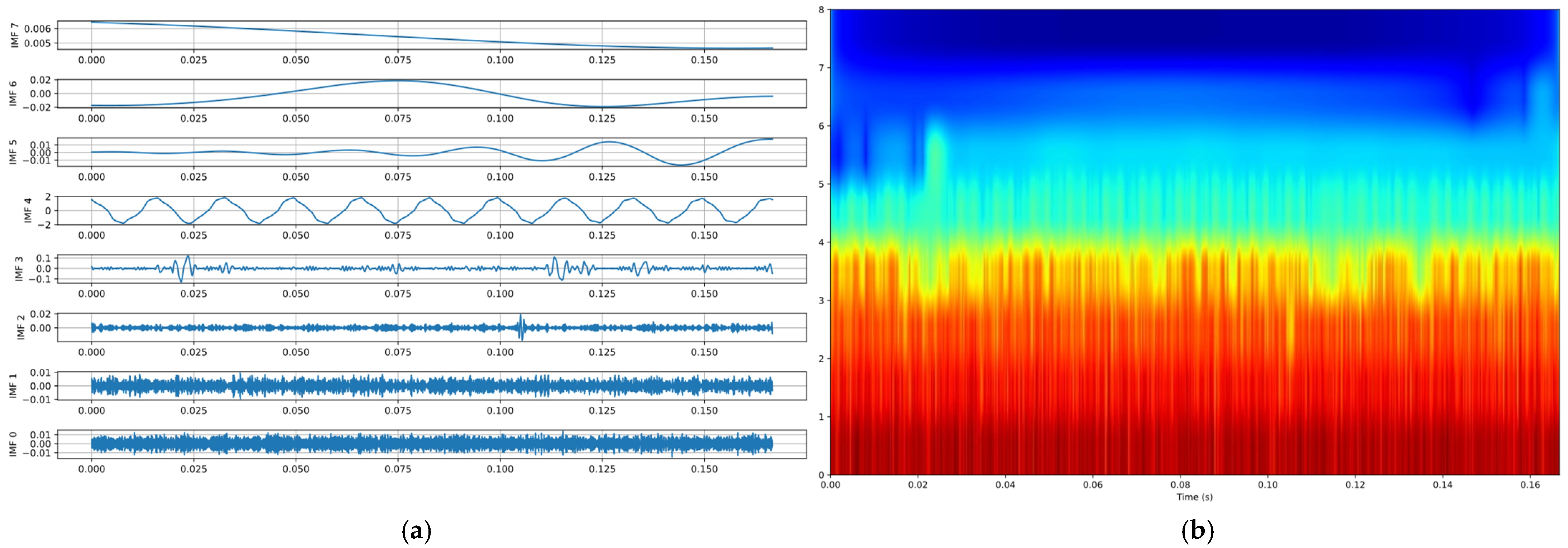

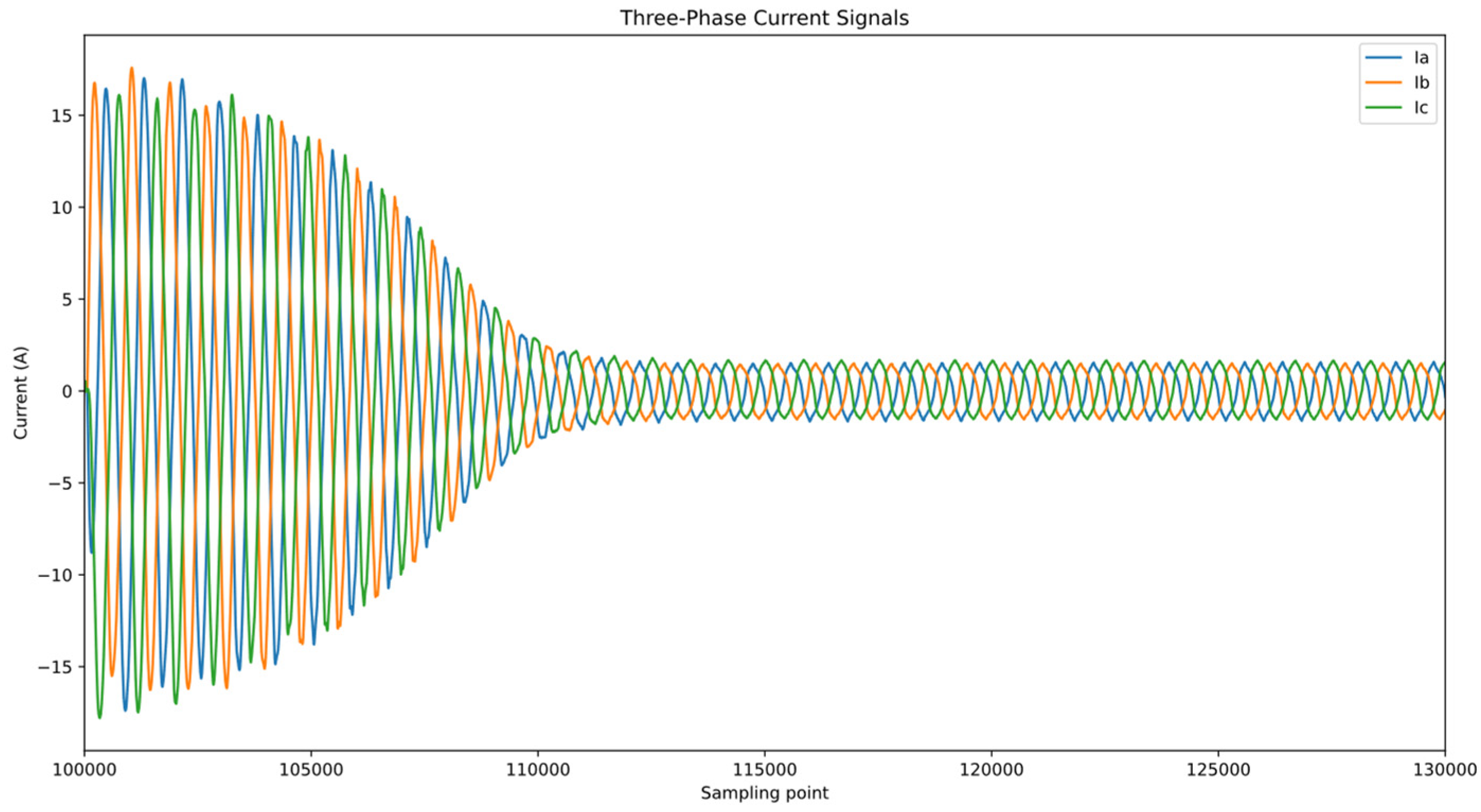
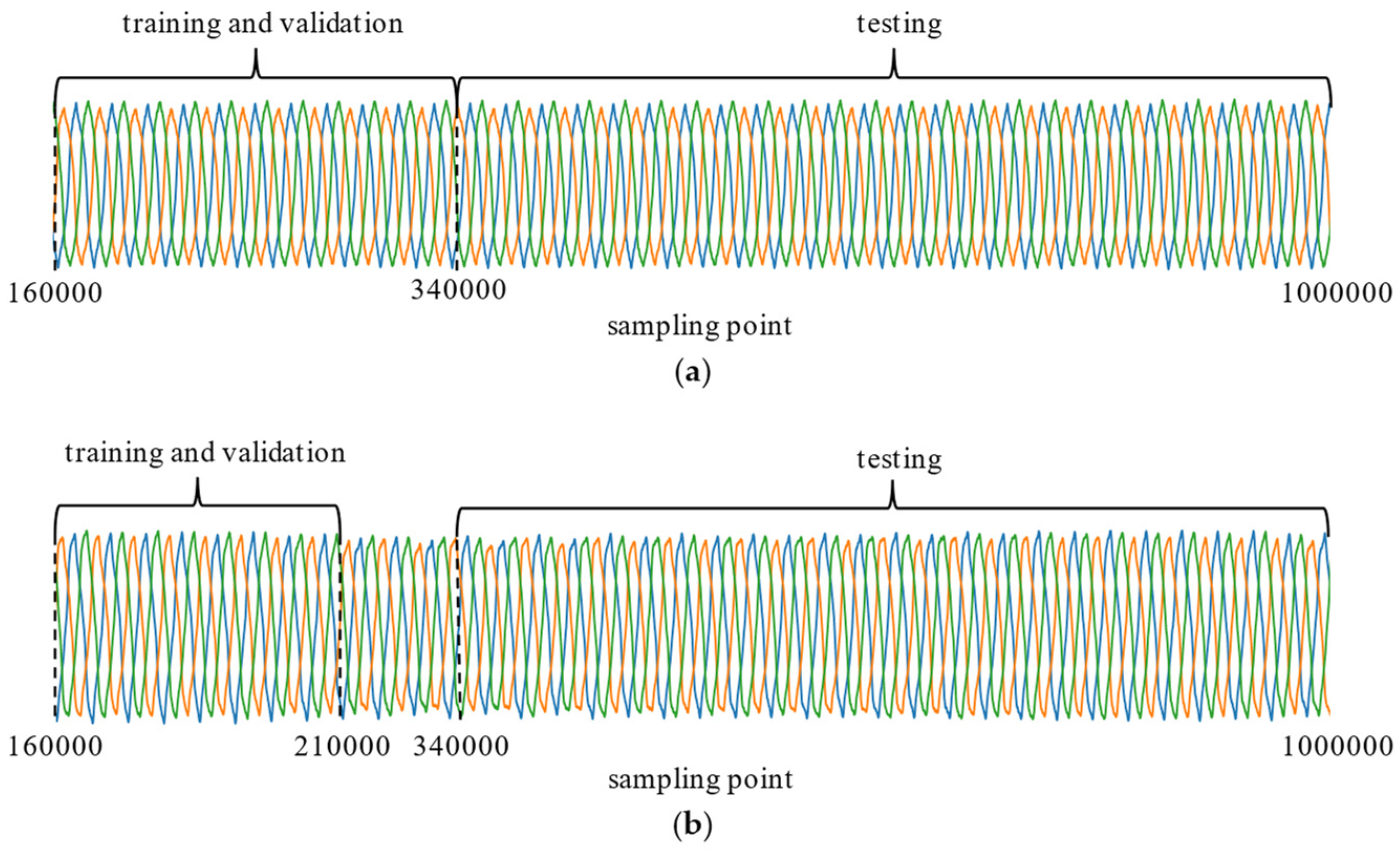
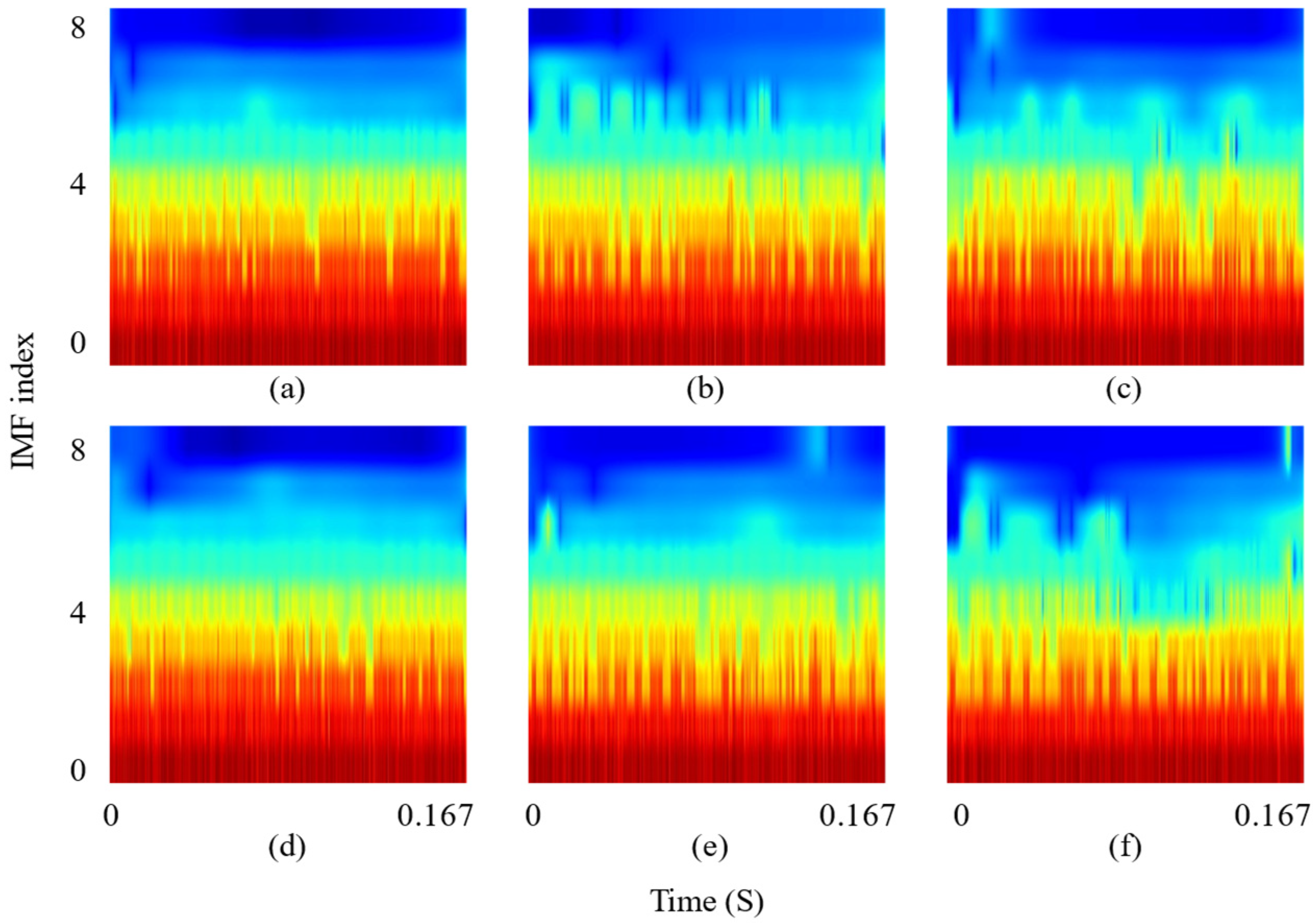
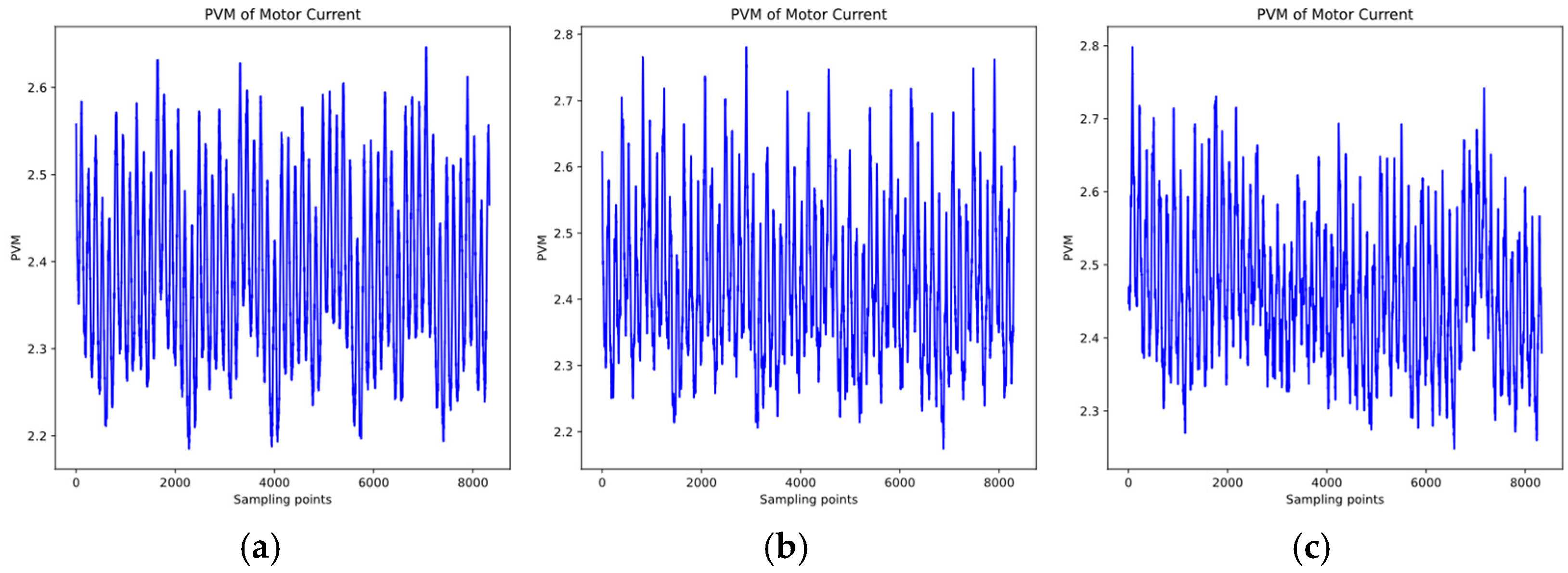

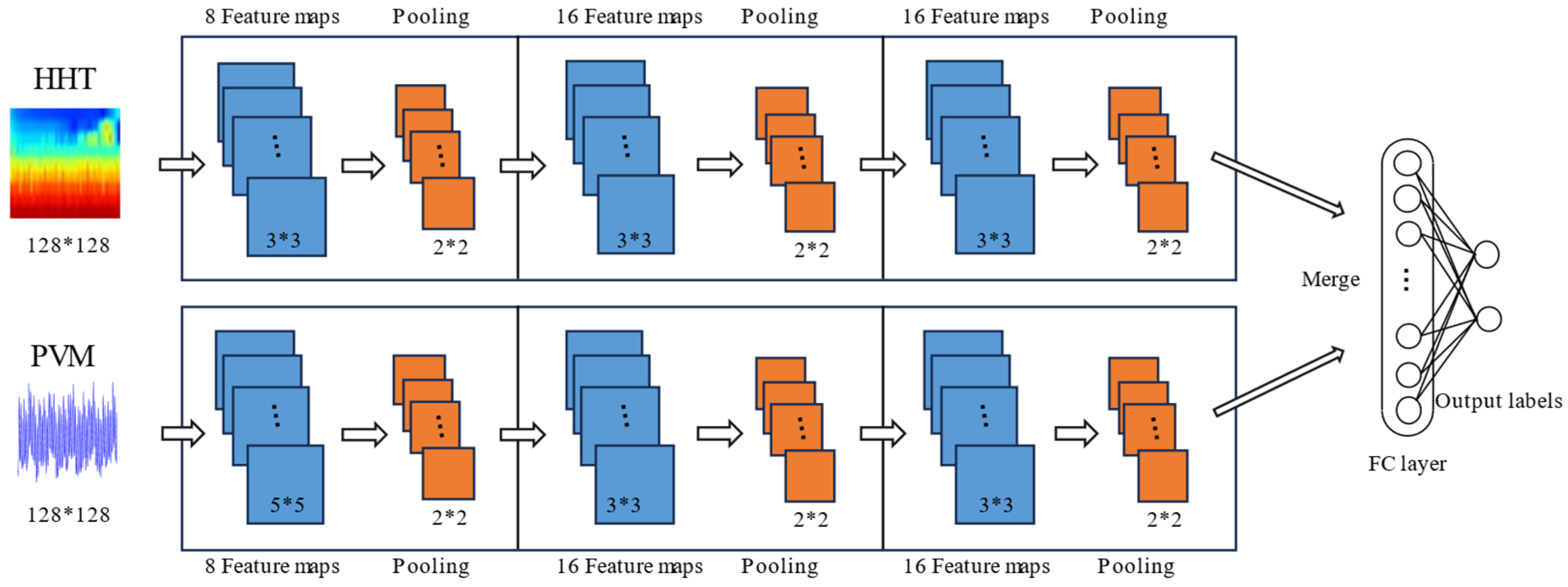
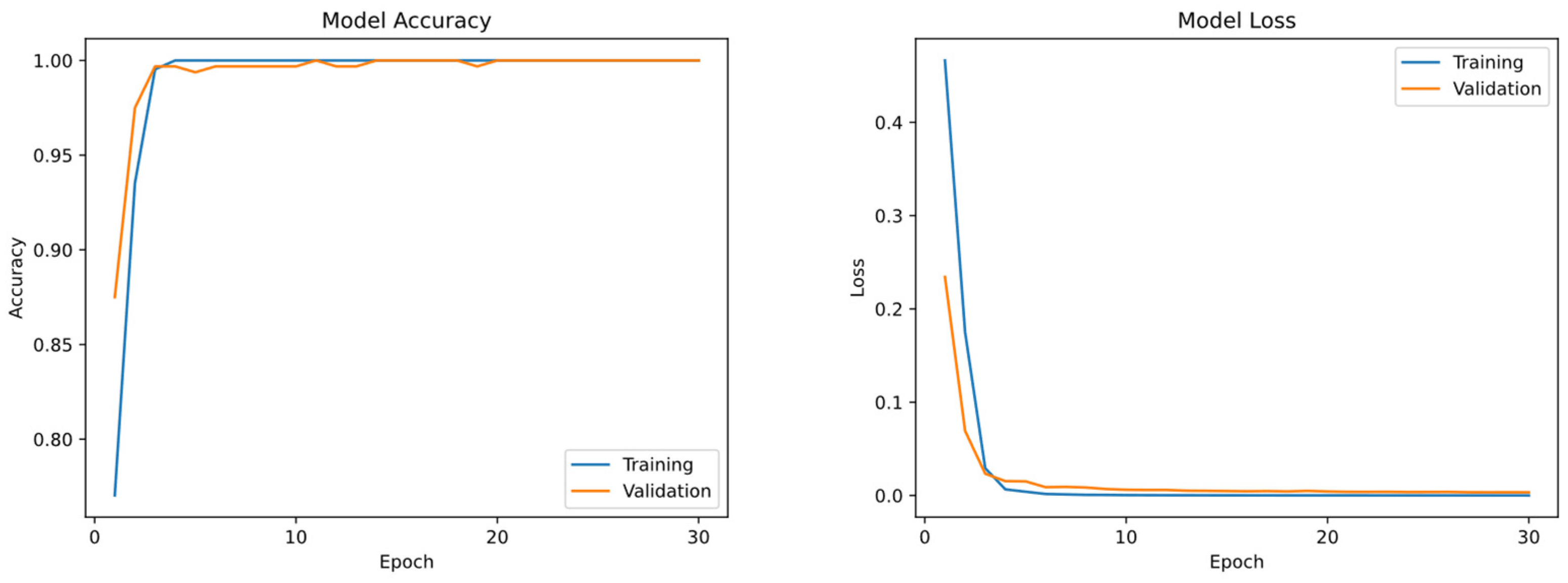
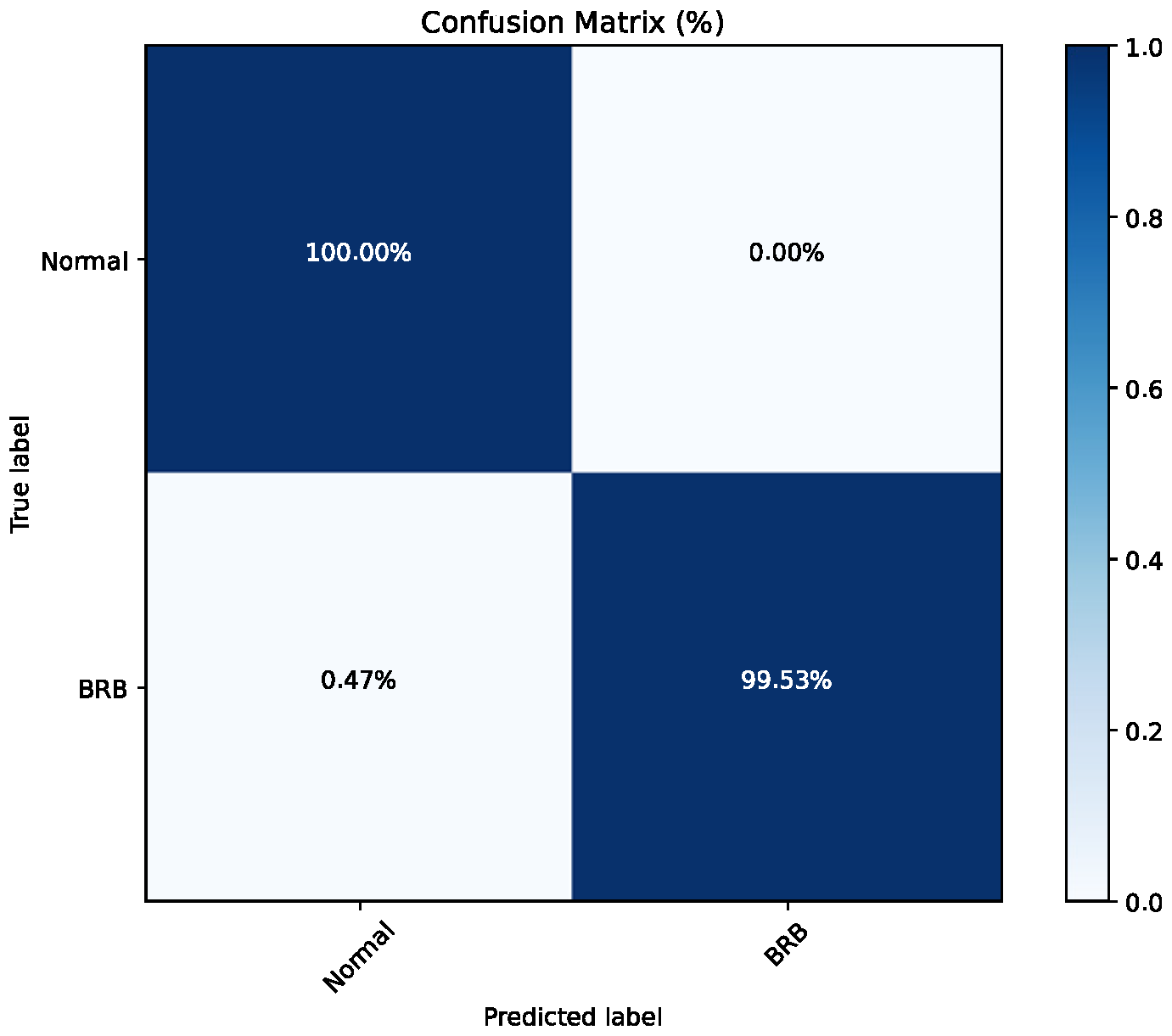
| Precision | Recall | F1-Score | Support | |
|---|---|---|---|---|
| Normal | 0.981366 | 1 | 0.990596 | 316 |
| BRB | 1 | 0.995253 | 0.997621 | 1264 |
| Accuracy | 0.996203 | 1580 | ||
| Macro Avg | 0.990683 | 0.997627 | 0.994108 | 1580 |
| Weighted Avg | 0.996273 | 0.996203 | 0.996216 | 1580 |
| 25% Load | 50% Load | 75% Load | 100% Load | |
|---|---|---|---|---|
| Normal | 100% | 100% | 100% | 100% |
| 1 BRB | 95.0% | 97.5% | 100% | 100% |
| 2 BRB | 100% | 100% | 100% | 100% |
| 3 BRB | 100% | 100% | 100% | 100% |
| 4 BRB | 100% | 100% | 100% | 100% |
| Method | Mean Test Accuracy ± Standard Deviation |
|---|---|
| PVM single signal | 0.9875 ± 0.0069 |
| HHT single signal | 0.9616 ± 0.0181 |
| TFD single signal | 0.9880 ± 0.0072 |
| PVM+TFD Merged | 0.9975 ± 0.0029 |
| HHT+TFD Merged | 0.9936 ± 0.0115 |
| HHT+PVM Merged | 0.9980 ± 0.0030 |
| Average | Standard Deviation | Minimum | Maximum | |
|---|---|---|---|---|
| HHT Transform | 12.4978 | 1.6806 | 9.6252 | 17.4304 |
| PVM Transform | 1.3462 | 0.2835 | 1.1206 | 2.1740 |
| Model Inference | 0.0746 | 0.0426 | 0.0535 | 0.2436 |
| Total Pipeline | 13.9296 | 1.8114 | 11.1852 | 18.9608 |
Disclaimer/Publisher’s Note: The statements, opinions and data contained in all publications are solely those of the individual author(s) and contributor(s) and not of MDPI and/or the editor(s). MDPI and/or the editor(s) disclaim responsibility for any injury to people or property resulting from any ideas, methods, instructions or products referred to in the content. |
© 2025 by the authors. Licensee MDPI, Basel, Switzerland. This article is an open access article distributed under the terms and conditions of the Creative Commons Attribution (CC BY) license (https://creativecommons.org/licenses/by/4.0/).
Share and Cite
Wang, T.; Wen, S.; Sheng, S.; Ma, H. Multi-Signal Induction Motor Broken Rotor Bar Detection Based on Merged Convolutional Neural Network. Actuators 2025, 14, 113. https://doi.org/10.3390/act14030113
Wang T, Wen S, Sheng S, Ma H. Multi-Signal Induction Motor Broken Rotor Bar Detection Based on Merged Convolutional Neural Network. Actuators. 2025; 14(3):113. https://doi.org/10.3390/act14030113
Chicago/Turabian StyleWang, Tianyi, Shiguang Wen, Shaotong Sheng, and Huimin Ma. 2025. "Multi-Signal Induction Motor Broken Rotor Bar Detection Based on Merged Convolutional Neural Network" Actuators 14, no. 3: 113. https://doi.org/10.3390/act14030113
APA StyleWang, T., Wen, S., Sheng, S., & Ma, H. (2025). Multi-Signal Induction Motor Broken Rotor Bar Detection Based on Merged Convolutional Neural Network. Actuators, 14(3), 113. https://doi.org/10.3390/act14030113





